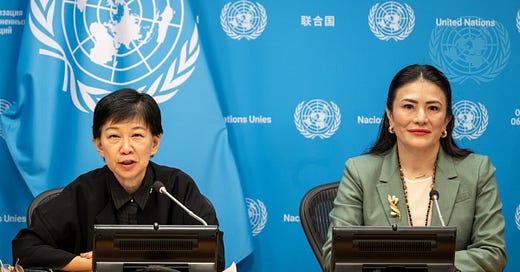Can states mobilise in the General Assembly to regulate autonomous weapons?
As First Committee kicks off supporters of new regulations need to use their numbers to plot a route towards a treaty

The last month has shown that new global rules on autonomous weapons systems will not be negotiated in a consensus-bound forum. The Convention on Certain Conventional Weapons (CCW)—the Geneva weapons forum where Government experts met at the end of August—moves at the pace of the slowest, if at all. While this route has a chance to adopt new legally binding rules in 2026, most commentators expect discussions to remain in the doldrums for the foreseeable future.
The recent Pact for the Future - another consensus process—this time involving all 193 UN member states—was co-opted by powerful countries with advanced militaries opposed to international regulation of autonomous weapons. The result was platitudes and language saying the issue should stay in its lane in Geneva’s CCW—where the powerful can continue to block.
New York’s General Assembly is a different beast. All UN member states are represented and decisions can be made by majority. The issue will be taken up there later this month for the second year running, with a draft resolution led by Austria together with a group of co-sponsors proposing that the UN initiates “informal consultations” on an autonomous weapons treaty, which the majority of UN member states supports. The initiative faced harsh criticism at an informal meeting in Geneva on Thursday 26 September, where a group of western states expressed concerns that a New York-based process could “duplicate" and “undermine” work in the CCW. Yet, as these voices constitute a minority view in the General Assembly, the resolution is widely expected to pass.
Spoiler Alert caught up with Austrian diplomat Alexander Kmentt on the fallout from the Pact of the Future and what momentum can be carried through into First Committee:
“The disarmament chapter for the Pact for the Future is unfortunately not very ambitious and a few delegations pushed for weakening the text in the final days of the negotiations. The text is particularly weak on autonomous weapons systems and is lacking urgency and a clear commitment to negotiate a legally binding instrument with prohibitions and regulations of these weapons to ensure a meaningful level of human control. We will continue with this discussion at the First Committee next month and hopefully instill more sense of urgency into the debate about [autonomous weapon systems].”
What’s the tactic? On paper, there is a strong majority for new international rules—a majority that could easily win the day in the General Assembly. But there may not be sufficient appetite to utilise this route, at least not at present. Would-be supporters are warded away by powerful states that want to keep control of this agenda.
For others, it’s more territorial: the issue is led by Geneva diplomats keen to guard their ownership of the brief. And a third group may see some genuine promise in the possibility of achieving a weak instrument in Geneva—with the world’s most advanced militaries inside the tent.
These dynamics combine to take the wind out of the sails of the General Assembly route—for now. But the new resolution will keep the General Assembly’s door firmly ajar while building ownership and expertise on the issue in New York. And Pact negotiations, despite the outcome, revealed signs of growing momentum:
193 world leaders have now endorsed the need to act “with urgency” to respond to the threat of autonomous weapons
The Group of Latin America and Caribbean Countries appear to have arrived at a common position in support of concluding a legally binding instrument by 2026 (mirroring the call from the UN Secretary-General)
Divisions within the EU on regulating autonomous weapons suggest they will struggle to mobilise on this issue leaving latitude for those on the fence to de-couple their position from powerful allies like France (a permanent member of the Security Council that has not yet supported a legally binding instrument) and Germany (who has supported an instrument but insists it should be negotiated in Geneva). We saw this during Pact negotiations where the EU did not object to strong early drafts calling for a legally binding instrument by 2026.
There are signs that the UK (another permanent member of the Security Council which has historically been opposed to new legally binding rules), may be shifting its policy under the new Labour Government. Last month, Prime Minister Keir Starmer used his maiden speech at the General Assembly to highlight the threat of new technologies being deployed by militaries without agreed international rules, stating that the issue was “too urgent to ignore”
The question of achieving a binding instrument to regulate autonomous weapon systems is not one of “if” but “when”. The startling pace of AI development and deployment of weapons systems makes the question critical. Will states advocating a new treaty mobilise and throw their weight behind the General Assembly route, or perhaps even go the way of the clusters or landmines treaties and take the process outside of the strictures of UN protocol? Or will they dither and wait for the dismal-looking 2026 Geneva opportunity to run its course? If the latter, civilians in fragile states may bear the consequences as the global industry in military AI continues unfettered for at least another two years.
The General Assembly’s First Committee — where this issue will be discussed — runs from 7 October to 8 November 2024. Spoiler Alert will follow discussions closely and report on what we hear.



